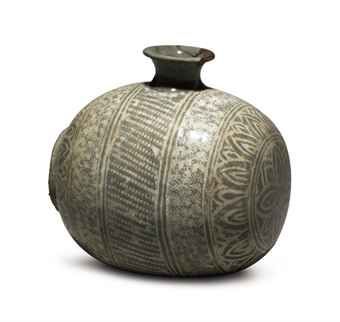A small slip-decorated buncheong stoneware bottle. Joseon dynasty (15th-16th century)
A small slip-decorated buncheong stoneware bottle. Joseon dynasty (15th-16th century). Photo: Christie's Images Ltd 2012
In the form of a rice bale, with a short flaring mouth rim, the rounded sides inlaid in white slip with a central band of diagonal dotted lines between delicate flowerhead and lotus-leaf bands, one end with a lotus-head medallion, the other with a knife-cut foot ring, the greyish stoneware applied with a green-tinged clear glaze with crackle and even lustre; 5½in. (14cm.) high; 5 5/8in. (14.3cm.) wide. Estimate $65,000 - $70,000
Notes: Bale-shaped flasks of the Joseon period are believed to have been made as wine vessels for ritual use. One end of the example here is inlaid in white slip with a large lotus medallion and the other end served as a raised ring foot when the vessel was fired. The small size and unusually fine bands of inlay are distinctive.
Buncheong, literally meaning "powder green," is a stoneware brushed or inlaid, as here, with white slip, liquid clay. A robust new era of ceramic design was ushered in by the early Joseon potters. It is typical of Joseon stoneware that the coarse clay body is heavily potted, here in pleasing contrast with the intricate inlay. The overglaze is thin and transparent with a greenish cast and satin sheen.
Christie's. Japanese & Korean Art, 11 September 2012. New York, Rockefeller Plaza www.christies.com

/https%3A%2F%2Fprofilepics.canalblog.com%2Fprofilepics%2F1%2F0%2F100183.jpg)
/https%3A%2F%2Fstorage.canalblog.com%2F03%2F02%2F119589%2F96711876_o.jpg)
/https%3A%2F%2Fstorage.canalblog.com%2F11%2F31%2F119589%2F94773502_o.jpg)
/https%3A%2F%2Fstorage.canalblog.com%2F20%2F83%2F119589%2F94772815_o.jpg)
/https%3A%2F%2Fstorage.canalblog.com%2F26%2F72%2F119589%2F75604929_o.jpg)
/https%3A%2F%2Fstorage.canalblog.com%2F59%2F60%2F119589%2F26458628_o.jpg)



/http%3A%2F%2Fstorage.canalblog.com%2F02%2F73%2F119589%2F128337060_o.jpg)
/http%3A%2F%2Fstorage.canalblog.com%2F38%2F63%2F119589%2F111567322_o.jpg)
/http%3A%2F%2Fstorage.canalblog.com%2F02%2F77%2F119589%2F92787074_o.jpg)
/http%3A%2F%2Fstorage.canalblog.com%2F89%2F00%2F119589%2F92170070_o.jpg)